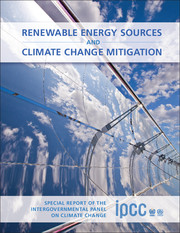 Renewable Energy Sources and Climate Change Mitigation
Renewable Energy Sources and Climate Change Mitigation Summary for Policymakers
Published online by Cambridge University Press: 05 December 2011
Summary
Introduction
The Working Group III Special Report on Renewable Energy Sources and Climate Change Mitigation (SRREN) presents an assessment of the literature on the scientific, technological, environmental, economic and social aspects of the contribution of six renewable energy (RE) sources to the mitigation of climate change. It is intended to provide policy relevant information to governments, intergovernmental processes and other interested parties. This Summary for Policymakers provides an overview of the SRREN, summarizing the essential findings.
The SRREN consists of 11 chapters. Chapter 1 sets the context for RE and climate change; Chapters 2 through 7 provide information on six RE technologies, and Chapters 8 through 11 address integrative issues (see Figure SPM.1).
References to chapters and sections are indicated with corresponding chapter and section numbers in square brackets. An explanation of terms, acronyms and chemical symbols used in this SPM can be found in the glossary of the SRREN (Annex I). Conventions and methodologies for determining costs, primary energy and other topics of analysis can be found in Annex II and Annex III. This report communicates uncertainty where relevant.
Renewable energy and climate change
Demand for energy and associated services, to meet social and economic development and improve human welfare and health, is increasing. All societies require energy services to meet basic human needs (e.g., lighting, cooking, space comfort, mobility and communication) and to serve productive processes. [1.1.1, 9.3.2] Since approximately 1850, global use of fossil fuels (coal, oil and gas) has increased to dominate energy supply, leading to a rapid growth in carbon dioxide (CO2) emissions.
- Type
- Chapter
- Information
- Renewable Energy Sources and Climate Change MitigationSpecial Report of the Intergovernmental Panel on Climate Change, pp. 3 - 26Publisher: Cambridge University PressPrint publication year: 2011
- 24
- Cited by
